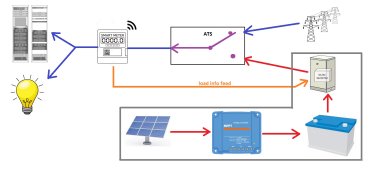Hi, totally new to PV. I have rather unique (maybe) situation: Got office in building, KWH costs are high, would like to power our server rack from solar as much as possible, optimized for money saving. Catch is we ourselves do not have contract with grid operator, we just pay rent (of which power costs are part) to building owner. The only option is to have strange off grid setup, where PV would be our main source and grid (stable and clean) our backup (grid plays a role of backup generator here). Goal is to produce and use as much power as we can, while having the PV 100% sandboxed, separated from gird and from office building power infrastructure.
Idea is simple: Panels connected to off grid inverter/mppt (or 2 separate devices, doesn't matter), some batteries mixed in, inverter supplies AC to ATS (which I got already anyway), if load exceeds inverter's ability to supply -> inverter AC output goes down (just output, not inverter itself, it needs to continue running to be able to charge batteries), ATS sees this and switches to grid. That far is more or less clear and simple. Now -> when inverter is able to supply the load 100% on its own (remember, there is no grid tied), it should turn its output back on, ATS sees the preferred source (inverter) is back on and switches back to inverter's AC output and keeps it as long as inverter is able to fully supply the load.
But how to "inform" inverter with output switched off about current load, if the load is on grid and inverter does not see it? Inverter needs to know if it will be able to supply the load (which varies). I imagine some kind of power meter between ATS and load feeding current consumption info to inverter. But what kind of meter? What is the inverter feature that enables this? What is the protocol? Is there some documentation for this?
I attach drawing, just simplified draft, forget about internals of PV part (grey marked), what I ask about is the ability of inverter to supply AC only if able to bare the load on its own.
Tx in advance for shedding any light on this topic.
Idea is simple: Panels connected to off grid inverter/mppt (or 2 separate devices, doesn't matter), some batteries mixed in, inverter supplies AC to ATS (which I got already anyway), if load exceeds inverter's ability to supply -> inverter AC output goes down (just output, not inverter itself, it needs to continue running to be able to charge batteries), ATS sees this and switches to grid. That far is more or less clear and simple. Now -> when inverter is able to supply the load 100% on its own (remember, there is no grid tied), it should turn its output back on, ATS sees the preferred source (inverter) is back on and switches back to inverter's AC output and keeps it as long as inverter is able to fully supply the load.
But how to "inform" inverter with output switched off about current load, if the load is on grid and inverter does not see it? Inverter needs to know if it will be able to supply the load (which varies). I imagine some kind of power meter between ATS and load feeding current consumption info to inverter. But what kind of meter? What is the inverter feature that enables this? What is the protocol? Is there some documentation for this?
I attach drawing, just simplified draft, forget about internals of PV part (grey marked), what I ask about is the ability of inverter to supply AC only if able to bare the load on its own.
Tx in advance for shedding any light on this topic.



